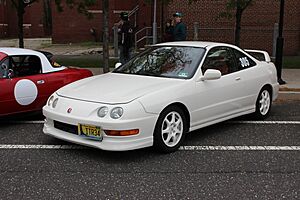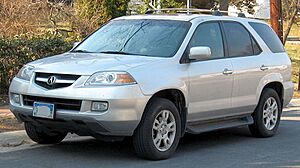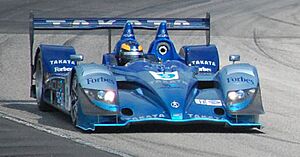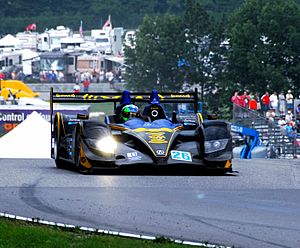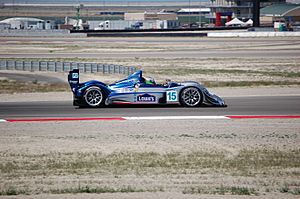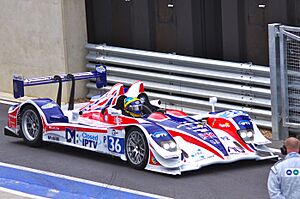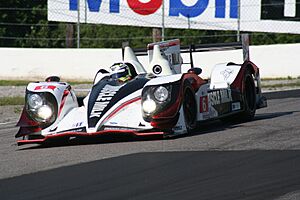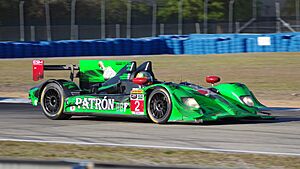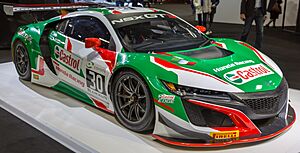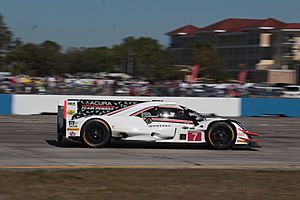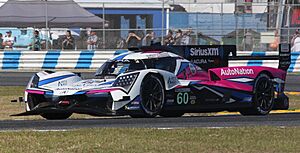Acura facts for kids
 |
|
| Division | |
| Industry | Automotive |
| Founded | March 27, 1986 |
| Founder | Soichiro Honda |
| Headquarters |
|
|
Area served
|
|
|
Key people
|
|
| Products |
|
| Brands | A-Spec, Type-S |
| Services | Automotive financing |
| Parent | American Honda Motor Company |
Acura is a special brand of cars made by Honda, a Japanese company. It focuses on luxury and high-performance vehicles. Most Acura cars are sold in North America. Acura started on March 27, 1986, to sell fancy and sporty cars. You can find Acura cars in the United States, Canada, Mexico, Panama, and Kuwait. In the past, they also sold cars in China, Hong Kong, Russia, and Ukraine. Plans to bring Acura to Japan in the late 2000s did not happen.
Acura was the first luxury car brand created by a Japanese automaker. When Acura launched, Honda also opened a new dealership channel in Japan called Honda Clio. This channel sold luxury cars, joining others like Honda Verno and Honda Primo. In its early years, Acura was one of the top-selling luxury brands in the US. It even sold more cars than well-known brands like BMW and Mercedes-Benz. Although sales went down in the mid-to-late 1990s, the brand became popular again in the early 2000s. This was thanks to new designs and new car models.
In the late 1980s, Acura's first main car, the Legend, was very successful. This inspired other Japanese carmakers, Toyota and Nissan, to create their own luxury brands, Lexus and Infiniti. In 1990, Acura launched the NSX. This was a special sports car with its engine in the middle. It offered a reliable and practical choice compared to expensive European sports cars. The NSX also brought Honda's VTEC engine technology to North America. The 1993 Legend coupe was the first Acura to use a six-speed manual transmission with a powerful engine. In the late 1990s, Acura made a special Type R version of its small Integra car. This version was lighter, had a stiffer and lower suspension, and a very powerful VTEC engine.
In the early 2000s, Acura introduced new models. These included the MDX, which was Acura's first original SUV. They also launched the RSX and TSX models. These cars replaced the Integra coupe and sedan. Special Type-S versions of the RSX, CL, and TL were added to the lineup. Acura's 2005 RL luxury car introduced SH-AWD. This is a special all-wheel drive system that can send power to individual wheels. The 2007 RDX, a crossover SUV, was the first Honda car in North America to use a turbocharged engine. A second generation NSX was released in 2016. It has a twin-turbocharged engine, a nine-speed dual-clutch transmission, and a Sport Hybrid SH-AWD system.
In 2024, Acura showed off a new electric performance car concept at Monterey Car Week.
Contents
What "Acura" Means and Its Logo
The name Acura comes from the Latin word "acutus," which means "to sharpen." The Acura logo looks like a caliper. A caliper is a tool used for very precise measurements. This represents the careful attention to detail that goes into every Acura car. The logo also looks a lot like Honda's "H" logo, with the top parts of the sides squeezed together.
Acura's Journey Through Time
The 1980s: A New Beginning
Acura was created around the same time that other Japanese car companies, Nissan and Toyota, developed their own luxury brands, Infiniti and Lexus. The Japanese government had rules about how many cars could be sent to the U.S. market. This made it more profitable for Japanese carmakers to send more expensive cars to the U.S.
After ten years of research, Honda opened 60 new dealerships in North America in 1986. These dealerships were for its new Acura car brand. Acura was the first Japanese luxury brand. Its slogan was "Acura. Precision Crafted Automobiles." At first, Acura offered two models: the larger Legend and the smaller Integra. The Integra was available as a five-door or three-door hatchback. The Legend was developed with a UK company called Austin Rover Group. It shared some parts with the Rover 800 series. The Integra was an improved version of the Honda Quint hatchback.
These cars, especially the Legend, were very successful. This success led other Japanese luxury brands to start. Toyota began developing Lexus in 1983, and Nissan started Infiniti in 1985. The goal of the Legend was to compete with cars like the Toyota Crown and Nissan Cedric. When the Legend was released in 1986, other companies like Toyota, Nissan, and Lincoln noticed how popular it was. They then offered their own luxury cars to compete.
In 1987, Acura's first full year of sales, they sold 109,000 cars. The main Legend sedan accounted for 55,000 of those sales. By 1990, Acura was selling 138,000 vehicles. This included 54,000 Legends. For comparison, Mercedes-Benz sold 78,000 cars that year, and BMW and Lexus each sold 64,000.
The 1990s: Challenges and Changes
In 1990, five years after the Legend and Integra came out, Acura introduced the NSX. This was a sports car with a V6 engine in the middle and rear-wheel drive. The NSX stood for "New Sports eXperimental." It was promoted as the first Japanese car that could compete with Ferrari and Porsche. This car helped build the image for both Honda and Acura brands. It also introduced Honda's VTEC engine technology. The NSX was the world's first production car made entirely of aluminum. Many people saw it as an "everyday supercar" because it was easy to use, high quality, and reliable. These traits were rare for supercars at the time. With the NSX, Acura introduced its "A-badge." This logo looks like a stylized pair of calipers, showing that Acura cars are built to very exact standards.
Even though Acura started strong, sales went down in the mid-to-late 1990s. Some people thought this was because the car designs were less exciting. Many cars were just re-branded Hondas from Japan, like the Acura Vigor in 1992. Also, during this time, Acura started using letters and numbers for car names instead of names like Legend, Vigor, and Integra. For example, the 1996 3.5 RL replaced the popular Legend. Many felt these new names were less memorable than the old ones.
Honda, the parent company, was also affected by a downturn in the Japanese economy during the 1990s. This period is known in Japan as the Lost Decade.
During this time, NSX sales also dropped because Acura made few changes to the car from its original 1990 design. A year later, the Integra sedan was no longer sold in Canada. It was replaced by the Acura 1.6 EL, which was a rebadged Honda Civic. The Integra sedan continued to be sold in the United States until 2001.
Despite these challenges, Acura became popular in the 1990s with young car enthusiasts who liked to "tune" cars. Honda had a reputation for making engines that were "easy-to-tune" and "rev-happy." This helped the Integra become a very popular car for tuning.
The Early 2000s: A Comeback
Around the year 2000, Acura started to become popular again. This happened because they introduced several redesigned car models. The first of these was the 1999 Acura 3.2 TL, a fancy sedan. Experts said that while the 3.2 TL didn't beat its competitors in every way, it offered a good mix of sportiness and luxury. These features, along with the TL's good price, made it very popular with buyers. Newer Acura models have followed a similar idea: offering lots of standard features with few extra options.
Another updated Acura model from the early 2000s was the MDX. This was a popular three-row crossover SUV based on the Honda Odyssey minivan. The MDX replaced the SLX, which was just a rebadged Isuzu Trooper and didn't sell well. The MDX was a car-like SUV that was good for families and suited the luxury SUV market. It received high praise in its first comparison test against seven other SUVs. Other Acura cars at this time included the 3.2 TL, 3.2 CL, RSX (which used to be the Integra hatchback), and the NSX. By the late 2000s, Acura stopped including engine size numbers in its car names. They used simpler two- or three-letter names instead (for example, 3.5 RL became RL).
In 2001, a new coupe called the RSX was added to the Acura lineup. It replaced the Integra. The RSX was a rebadged Honda Integra (DC5) from the Japanese market. So, the RSX was technically a new version of the Integra. Like the Integra, the RSX was a hit with car tuners. However, at the end of 2006, the RSX was removed from the Acura lineup. Acura said they wanted to move up in the luxury car market and couldn't sell a car mostly driven by teenagers.
2004–2006: More New Models
A new TL was introduced for the 2004 model year. It had a 270 horsepower V6 engine. The new TL greatly increased sales, with 70,943 units sold in America in 2005.
Around the same time, the Acura TSX was introduced. This car was basically a re-badged European and Japanese Honda Accord, packed with features. This model became the only 4-cylinder sedan in Acura's lineup.
Acura's new models, especially the TL and TSX, were well-liked by car reviewers. They became Acura's best-selling vehicles. The TSX was on Car and Driver's Ten Best list from 2004 to 2006.
In 2005, a new RL was introduced with a 300 horsepower V6 engine, improved looks, and Super Handling All-Wheel Drive (SH-AWD). This system can send almost all of the RL's power to just one wheel when turning. The second-generation RL appeared on Car and Driver's Ten Best list for 2005. However, in the mid-size luxury car market, RL sales were much lower than German cars and even other Japanese cars like the Lexus GS. Honda Japan had set the RL's first price very high, close to cars with V8 engines. This disappointed potential customers who felt Acura wasn't as prestigious as its German rivals and expected more value.
In 2006, Acura introduced a compact crossover SUV called the RDX. It became available to U.S. buyers in August 2006. It has a turbocharged 240-horsepower 4-cylinder engine and, like the RL, uses Acura's SH-AWD system. A completely redesigned MDX became available in the fall of 2006. It had a 300 horsepower V6 engine and Super Handling All-Wheel Drive.
2007–2013: New Designs and Concepts
Acura brought back the TL Type-S for the 2007 model year. The years 2009 saw all-new TL and TSX models, as well as an update for the RL. All three debuted in 2008. Acura planned to redesign the RL by 2011. They also announced a brand new luxury crossover vehicle called the ZDX.
The ZDX was the first car designed in Acura's design studio in Torrance, California. Michelle Christensen designed the ZDX. It was based on the Acura MDX, using that car's 3.7 liter V6 engine (300 horsepower) and SH-AWD system. It was also the first Acura car built entirely in North America. The production model of the ZDX was shown at the Orange County Auto Show on October 15, 2009. The idea behind the ZDX was that it was a "four-door coupe." Its body design was meant to look like a "pulled back slingshot." Another important design feature of the ZDX was its wide rear shoulders above the back wheels. The ZDX went on sale in December 2009.
Acura originally planned for the third generation of the RL to be a rear-wheel drive V8 sedan. This would have been their main luxury car. However, they stopped these plans because of the economic downturn in 2008.
Acura announced a new TSX wagon at the 2010 New York Auto Show. It went on sale in the Fall of 2010. The wagon version of the TSX was based on the wagon version of the European Honda Accord.
For the 2010 model year, the MDX models received small changes to their outside look and more features. The engine stayed the same, but the transmission was updated from 5-speeds to 6-speeds. This new transmission was also used in the ZDX.
In 2012, Acura introduced a new model called the ILX. This car replaced the Acura CSX in Canada and was based on the Honda Civic platform. The ILX first offered three engine choices: a 1.5L four-cylinder electric hybrid, a 2.0L 4-cylinder engine, or a 2.4L engine with a 6-speed manual transmission. Acura also showed the Acura RLX Concept, which would replace the RL sedan, at the New York International Auto Show. The ILX went on sale in May 2012 in the United States as a 2013 model.
Also in 2012, Acura updated another model, the RDX concept. For the new model, Acura replaced the 4-cylinder turbo engine with a 3.5L V6. When the official 2013 Acura RDX was released, it looked similar to the concept but had changes to its wheels, taillights, and other small details. The 2013 RDX did not have the SH-AWD system. Instead, it had "AWD with intelligent control," similar to the CR-V's AWD system.
In 2013, Acura showed a 2014 Concept of the MDX. Soon after, it was released to the public. The MDX competes with cars like the Lexus RX and Audi Q7.
In December 2013, at the Los Angeles Auto Show, Acura showed a Sport Hybrid SH-AWD version of the RLX sedan. It had a 310-horsepower 3.5L V6 engine and two electric motors. These motors together generated 377 horsepower through a new 7-speed dual clutch transmission. The 2014 RLX Sport Hybrid SH-AWD also featured an electronic gear selector. This replaced the traditional gear lever with push-buttons for selecting modes like Park, Drive, and Reverse. The new RLX Sport Hybrid went on sale in mid-2014.
2014–Present: Modern Acura Cars
In January 2014, at the Detroit Auto Show, Acura showed the all-new 2015 TLX sports sedan. This new car replaced the TSX and TL sedans, which were being discontinued. The 2.4-liter TLX came with Acura's new eight-speed dual clutch DCT transmission. The more powerful 3.5-liter V6 model came with a new nine-speed transmission and Super-Handling All Wheel Drive (SH-AWD). The TLX went on sale in the Summer of 2014.
In 2015, Acura redesigned the ILX for the 2016 model year. It was now only available with a 2.4L engine and an 8-speed dual clutch transmission (DCT). It also added Acura's special Jewel Eye LED headlights, LED taillights, updated wheels, and suspension changes. New packages were offered, like the AcuraWatch Package (which includes safety features like adaptive cruise control and collision warning) and A-Spec (for a sportier look).
The 2016 RDX was also redesigned. It featured the same 3.5L 6-speed automatic transmission with small adjustments for better fuel efficiency and more horsepower. The RDX also got the Acura Jewel Eye LED headlights. A new Advance Package was offered, including parking sensors, rain-sensing wipers, and remote start.
In 2017, Acura considered opening a branch in India.
Racing and Performance
Acura has been involved in American motorsports almost since it started. This includes races like the Sports Car Club of America (SCCA) and IMSA GT Championship series. In 1991, Acura teamed up with Comptech Racing to use the V6 engine from the Acura NSX in Comptech's prototype race car. Acura won the championship in its first year, including a class win at the 24 Hours of Daytona. Acura and Comptech won championships again in 1992 and 1993.
Changes in racing rules led Acura to move to touring car racing. They joined Realtime Racing in the SCCA World Challenge with the NSX in 1996, winning the last two races of the season. In 1997, Acura added Integra cars to lower classes and won championships in both. Realtime won the touring championship with the Integra again in 1998 and came very close to winning it again in 1999. They then won the title again in 2000.
Even though Realtime stopped using the NSX in 1998, the NSXs returned to the top class in 2001. By 2002, Acura replaced the old Integra with the new Acura RSX in the final races of the season. At the same time, Acura stopped using the NSXs in the top GT class. The RSXs were later joined by new Acura TSXs in 2004. Realtime continues to race the RSX and TSX in the SCCA Speed World Challenge. Acura also races RSXs and TSXs in the Grand American Road Racing Association's KONI Challenge Series for touring cars.
At the Detroit Auto Show in 2006, Acura announced plans to enter the American Le Mans Series. They would use multiple teams with Le Mans prototypes in the LMP2 class starting in the 2007 season. The cars would use chassis from other manufacturers but have American-built Acura V8 engines. This was a first for Acura and Honda. Acura also announced plans to take the cars to the 24 Hours of Le Mans in 2008. They eventually planned to move to the more powerful LMP1 class with cars built by Acura themselves in 2009.
The three Acura-powered prototypes debuted at the 2007 12 Hours of Sebring. This was the first race of the ALMS season, and they were successful. One Acura car took second place overall and first in its class. Acura also began developing its own chassis by changing their purchased Courage chassis a lot. These cars are now called Acura ARX-01a.
In 2009, Acura made its first LMP1 car, the Acura ARX-02a. In 2010, Honda renamed all Acura prototypes as Honda Performance Development (HPD) cars. They announced that all future prototypes would be built under the HPD name.
Acura did not race again until 2013. Two Acura ILXs were entered in the 25 Hours of Thunderhill race by Honda R&D Americas designers and engineers. The car had to stop racing due to engine problems.
The Acura ILXs returned to Thunderhill for the 2014 25-hour race. This time, the car won its class and finished 8th overall. At the 2016 New York International Auto Show, Acura announced the GT3 version of the NSX. This car began racing in 2017 with factory support in both the WeatherTech SportsCar Championship's GTD class and Pirelli World Challenge GT class. The car races under the Honda brand outside North America.
Acura Racecars
Marketing and Promotions
The Acura logo was introduced in 1990 for the 1991 car models. According to Honda, it represents a caliper. This is a tool used for precise measurements. It can also look like a slanted "H" for Honda or a stylized "A" for Acura.
Acura's current marketing slogan is "Precision Crafted Performance." Recent models offer different trim levels like Technology, Advance, Type-S, SH-AWD, and A-Spec. Technology and Advance models usually come with the newest high-tech features. These include keyless start and a blind spot information system. Type-S and SH-AWD models are focused on performance. They have a lot more horsepower than the lower trim levels. Some models, like the TL, combine these trim levels.
Acura started working with Marvel Entertainment in 2010. This began with the movie Iron Man 2, which showed a ZDX after the credits. In April 2011, Acura and Marvel announced a partnership. Acura became the official car brand of Marvel's fictional S.H.I.E.L.D. organization. Soon after, several Acura models appeared in the films Thor and Captain America: The First Avenger. In the 2012 movie, The Avengers, Iron Man drove a special sports car made by Acura just for the film.
From 1995 to 2007, Acura sponsored two WTA Tour tennis tournaments, both called the Acura Classic. In 2012, Acura was a main sponsor and official vehicle of the Sundance Film Festival.
Acura also has a 'Mobility Program'. This program helps drivers with disabilities. It offers money back for the cost of special equipment that helps disabled drivers use their vehicles safely.
Acura was the official shirt sponsor of the Columbus Crew soccer team from 2017 to 2020.
Current Acura Models
- 2001–present MDX (mid-size crossover SUV)
- 2007–present RDX (compact crossover SUV)
- 2025–present ADX (small crossover SUV)
- 2010–2013, 2024–present ZDX (mid-size electric crossover SUV)
- 1986–2001, 2023–present Integra (compact liftback sedan, replaces ILX)
Discontinued Acura Models
- 2014–2020 RLX (Mid-size luxury executive sedan, replaced RL)
- 2006–2011 CSX (compact sedan, replacement for the EL; only available in Canada, replaced by the ILX)
- 2004–2014 TSX (compact sports sedan, sport wagon, replaced by the TLX)
- 2015–2025 TLX (Executive sedan, replaces TL and TSX)
- 2002–2006 RSX (sports coupe, replacement for third generation Integra, replaced by the TSX)
- 1997–2005 EL (compact sedan, replaced Integra sedan; only available in Canada, replaced by the CSX)
- 1997–1999, 2001–2003 CL (luxury coupe, discontinued after 2003 model year)
- 1996–2014 TL (mid-size sports sedan, replaced by the TLX)
- 1996–2012 RL (full-size sedan, discontinued after 2012 model year, replaced by the RLX)
- 1996–1999 SLX (SUV, rebadged Isuzu Trooper, replaced by the MDX; only available in the United States)
- 1992–1994 Vigor (mid-sized sedan, replaced by the TL)
- 1986–1995 Legend (luxury sedan and coupe, renamed RL for 1996 model year)
- 1991–2005, 2017–2022 NSX (Exotic sports car)
- 2013–2022 ILX (Compact executive sedan, successor to the CSX and Integra)
- 2017–2022 CDX (small Luxury CUV, only available in China)
US Sales Figures
| Year | Total US sales |
|---|---|
| 1986 | 52,868 |
| 1987 | 109,470 |
| 1988 | 128,238 |
| 1989 | 142,061 |
| 1990 | 138,344 |
| 1991 | 143,708 |
| 1992 | 120,100 |
| 1993 | 108,291 |
| 1994 | 112,137 |
| 1995 | 97,451 |
| 1996 | 107,908 |
| 1997 | 108,143 |
| 1998 | 110,392 |
| 1999 | 118,006 |
| 2000 | 142,681 |
| 2001 | 170,109 |
| 2002 | 165,552 |
| 2003 | 170,915 |
| 2004 | 198,919 |
| 2005 | 209,610 |
| 2006 | 201,223 |
| 2007 | 180,104 |
| 2008 | 144,504 |
| 2009 | 105,723 |
| 2010 | 133,606 |
| 2011 | 123,299 |
| 2012 | 156,216 |
| 2013 | 165,436 |
| 2014 | 167,843 |
| 2015 | 177,165 |
| 2016 | 161,360 |
| 2017 | 154,602 |
| 2018 | 158,934 |
| 2019 | 157,385 |
| 2020 | 136,983 |
| 2021 | 157,408 |
See also
 In Spanish: Acura para niños
In Spanish: Acura para niños





